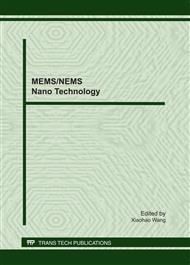p.62
p.66
p.70
p.75
p.78
p.83
p.89
p.97
p.103
Investigation on Silicon-Glass Electrostatic Bonding Time Experiment
Abstract:
In this paper, we make a detail analysis of some factors, which affects the electrostatic bonding process. According to the electrical properties of glass, combined with the principle of electrostatic bonding, we analysed the relationship of critical bonding time, voltage and temperature as well as the factors which affect electrostatic bonding. Then we come up with the mathematical model of the intensity and temperature of electrostatic bonding. In accordance with the above-mentioned formula and the experimental data, we can get the following conclusions: the intensity of electrostatic bonding is much greater between 280°C to 370°C; the best temperature for this bonding is about 350°C; however, when the temperature is below 280°C,the intensity of electrostatic bonding is lower due to the great impact of particles under low temperature; but when the temperature is higher than 370°C,the mismatch of coefficient of thermal expansion of silicon and glass gets larger, then as a result, the intensity of this bonding has a significant decrease with the increasing of temperature.
Info:
Periodical:
Pages:
78-82
Citation:
Online since:
June 2011
Authors:
Keywords:
Price:
Сopyright:
© 2011 Trans Tech Publications Ltd. All Rights Reserved
Share:
Citation:


